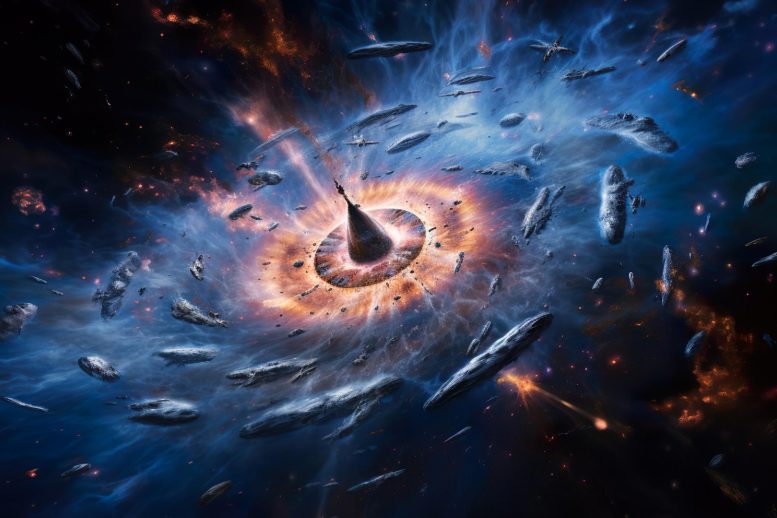
In a pioneering study, scientists have used quasars as cosmic clocks to observe the early universe running in extreme slow motion, further validating Einstein’s theory of general relativity. By examining data from nearly 200 quasars, hyperactive supermassive black holes in the centers of early galaxies, the team found that time appeared to flow five times slower when the universe was just over a billion years old.
Observational data from nearly 200 quasars show Einstein correct – again – about time dilation of the cosmos.
Scientists have for the first time observed the early universe running in extreme slow motion, unlocking one of the mysteries of Einstein’s expanding universe.
Einstein’s general theory of relativity means that we should observe the distant – and hence ancient – universe running much slower than the present day. However, peering back that far in time has proven elusive. Scientists have now cracked that mystery by using quasars as ‘clocks’.
“Looking back to a time when the universe was just over a billion years old, we see time appearing to flow five times slower,” said lead author of the study, Professor Geraint Lewis from the School of Physics and Sydney Institute for Astronomy at the University of Sydney.
“If you were there, in this infant universe, one second would seem like one second – but from our position, more than 12 billion years into the future, that early time appears to drag.”
The research was published on July 3 in Nature Astronomy.
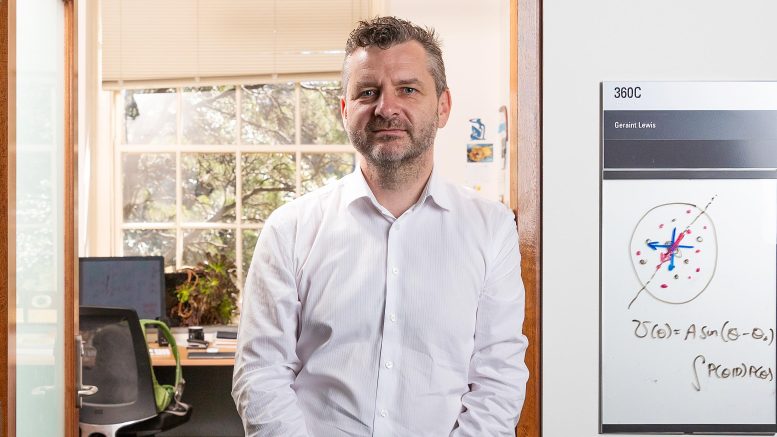
Professor Geraint Lewis in the Sydney Institute for Astronomy in the School of Physics at the University of Sydney. Credit: The University of Sydney
Professor Lewis and his collaborator, Dr. Brendon Brewer from the University of Auckland, used observed data from nearly 200 quasars – hyperactive supermassive black holes at the centers of early galaxies – to analyze this time dilation.
“Thanks to Einstein, we know that time and space are intertwined and, since the dawn of time in the singularity of the Big Bang, the universe has been expanding,” Professor Lewis said.
“This expansion of space means that our observations of the early universe should appear to be much slower than time flows today.
“In this paper, we have established that back to about a billion years after the Big Bang.”
Previously, astronomers have confirmed this slow-motion universe back to about half the age of the universe using supernovae – massive exploding stars – as ‘standard clocks’. But while supernovae are exceedingly bright, they are difficult to observe at the immense distances needed to peer into the early universe.
By observing quasars, this time horizon has been rolled back to just a tenth the age of the universe, confirming that the universe appears to speed up as it ages.
Professor Lewis said: “Where supernovae act like a single flash of light, making them easier to study, quasars are more complex, like an ongoing firework display.
“What we have done is unravel this firework display, showing that quasars, too, can be used as standard markers of time for the early universe.”
Professor Lewis worked with astro-statistician Dr. Brewer to examine details of 190 quasars observed over two decades. Combining the observations taken at different colors (or wavelengths) – green light, red light, and into the infrared – they were able to standardize the ‘ticking’ of each quasar. Through the application of Bayesian analysis, they found the expansion of the universe imprinted on each quasar’s ticking.
“With these exquisite data, we were able to chart the tick of the quasar clocks, revealing the influence of expanding space,” Professor Lewis said.
These results further confirm Einstein’s picture of an expanding universe but contrast earlier studies that had failed to identify the time dilation of distant quasars.
“These earlier studies led people to question whether quasars are truly cosmological objects, or even if the idea of expanding space is correct,” Professor Lewis said.
“With these new data and analysis, however, we’ve been able to find the elusive tick of the quasars and they behave just as Einstein’s relativity predicts,” he said.
Reference: “Detection of the cosmological time dilation of high-redshift quasars” by Geraint F. Lewis and Brendon J. Brewer, 3 July 2023, Nature Astronomy.
DOI: 10.1038/s41550-023-02029-2

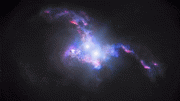
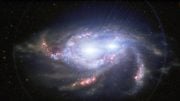

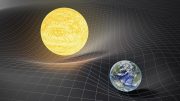
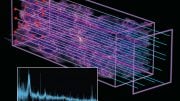
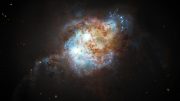
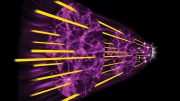
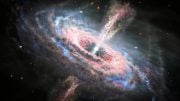
really, that’s so cool.
“If you were there, in this infant universe, one second would seem like one second – but from our position, more than 12 billion years into the future, that early time appears to drag.”
Nice. Not sure how that vindicates anyone in particular of anything coming out of nothing along with a beginning to time, however.
People need to stop with the Big Bang nonsense. The universe has always been. I know that’s difficult to grasp, but people aren’t expected to comprehend lack of a beginning.
People aren’t convinced without logical arguments.
I wish this were so.
LOGICAL ARGUMENTS!? Whose LOGIC, and what’s to ARGUE?
Time dilation? “Uh… We don’t know what we are seeing… Let’s haul Einstein out of his BOX and consult with the MATHS GENIE!”
YUP! LOGIC: The Human mind testing “Theories” which rely on the same faulted “LOGIC” that gave rise to a faulted ANALYSIS of the “PRIMUM MOBILE” (GOD in the Cosmic Machine?); the ULTIMATE CAUSE; which is the progenitor of our EFFECTED (Affected?) Existence.
Yep! The BIG BANG BOOM!
THAT solved, let’s get down to the BIZ of Blowing Ourselves up REAL GOOD!
NOW… put that Cosmological Gun in your mouth and SMOKE IT, GOMER.
Salvation is just a finger pull away!
DEFINITELY not a BANG but (apparently) a WHIMPER, Dorothy.
AUNTIE EM. AUNTIE EM! I’M AFRAID!!
NOT.
That’s a Cosmological Wet Fart. No ♥️ for You, Tin Man… until the Spirit Moves you.
I don’t think it’s quite really correct to say that time “flowed more slowly” in the early universe. It appears so, viewed from our vantage point, but that’s much different than implying there is some universal time which passed more slowly. Time varies in an elastic way according to the situation from which motion is observed.
This is process, not time. Time is a measuring instrument for the process. Process is mass & energy. Time is in your mind, not mass or energy.
Einstein said, soon after the big bang. I say long after it, compare the speed of turtle with earlier big bang.
Process is mass & energy. Time is in your mind.
Headline written for people forever exploiting the finer points of the royal religion of constant-over-the-whole-universe “c” and of course the headline completely disagrees with the soberest points in the article, which otherwise itself is vague. Looks like redshift is getting discounted to zero worth in favor of finding and exploiting delay variations in time-domain events. I’ll just note here that gravitational redshift (another totally subjective “one second still seemed like one second” concept – j/k) would not be a factor if there’s no discrepancy between the time-domain and frequency-domain measures.
Still waiting on the nanograv article from the royal un-quantum gravity cartel.
I dislike raining on anyone’s two decades old parade but whereas angular pulsing lines of gravity force radiate outward from all objects in generally spherical fields of declining density and attraction, and photons are proved to be massive enough to produce lensing when passing through the gravitational field of a large cosmic object between their source and the earth (and, as posted many times before in my senior lay opinion, the cause of the scattering of the dots in classic double slit experiments), I agree it was genius of Einstein to recognize the relationships between matter, energy and the speed of light in a vacuum on earth but I believe he got it wrong about ‘space-time’ and ‘time dilation;’ space, just ‘is’ and time just ‘isn’t.’
Because of the inevitable interaction between all objects and lines of gravity force in the so-called “time dilation experiments,” with mechanical or atomic clocks, to compel one clock to move through more lines of gravity force as another remains relatively stationary inherently causes the faster traveling clock, not time, to slow down. Therefore, for me personally now it not only remains questionable about how old and large the universe is but was there a ‘big bang’ and is it expanding at all? Actually, with most (if not all) of the observed cosmic objects rotating/spinning at various angles and distances, I think there probably was a big bang and the universe probably is expanding, but at a decreasing rate; red shift created by photons from distant sources slowing in earth’s field of gravity like cars on a road with increasing numbers of speed bumps.
To prove that time can be at different speeds this experiment has movement comparison not a good comparison of equal bases speed of a reactable mass to a invisible passing of images that make reality cognisant. Take the factors of human understanding to a place that exist without observational thought time still remains moving as a whispering Ghost. Ask what was time before the Bang.
Thanks for mentioning Einstein’s GR;the relativistic mechanics has a limit to function usual through equation perfectly for stars and black holes in the milky way.Now,for other galaxies,expansion of space with time can be given by Rotation of Galaxy and star dynamics.
Expansion of Space with Time pattern is rational to General Relativity aligned with increasing Mass(or Gravity) as time calculated from the big bang taken as origin.
So,time dialation at half of the age of universe and 1.5 billion years after the big bang are giving rational results defined by method of measurements.
LOGICAL ARGUMENTS!? Whose LOGIC, and what’s to ARGUE?
Time dilation? “Uh… We don’t know what we are seeing… Let’s haul Einstein out of his BOX and consult with the MATHS GENIE!”
YUP! LOGIC: The Human mind testing “Theories” which rely on the same faulted “LOGIC” that gave rise to a faulted ANALYSIS of the “PRIMUM MOBILE” (GOD in the Cosmic Machine?); the ULTIMATE CAUSE; which is the progenitor of our EFFECTED (Affected?) Existence.
Yep! The BIG BANG BOOM!
THAT solved, let’s get down to the BIZ of Blowing Ourselves up REAL GOOD!
NOW… put that Cosmological Gun in your mouth and SMOKE IT, GOMER.
Salvation is just a finger pull away!
DEFINITELY not a BANG but (apparently) a WHIMPER, Dorothy.
AUNTIE EM. AUNTIE EM! I’M AFRAID!!
NOT.
That’s a Cosmological Wet Fart. No ♥️ for You, Tin Man… until the Spirit Moves you.
OR this proves the new theory that the Universe is not accelerating. If it appears slower in the past and faster in the here and now, well, it’s all an ILLUSION.
Good,this is optional to use equation of general relativity for galaxies next to milky way;as exact result for calculation of space-time or gravity is changed by a constant of ratio.So,though studies of other galaxies gives good results by Einstein’s GR are rational or similar,but not exact in nature.The object of studìes are simply to enhance a comparable data to real occurance,in parallel view.This is how GR theory can be tested and utilized for study of galaxies than our milky way.
Dynamical studies are prefered and intrduced for real and comprehensible data of exact occurance.
Thus,ĺaws of gravity can be used with citation of their proper ĺimitations.
The real occurrence in galaxies other than milky way and preferrence of a method using Genral Relativity can suggest a result of an experimental observation only by a factor parallel,similar and varing with a constant of ratio.This is just fine and satisfactory here,for comparison.
The Space Time relationship derived from General Relativity,for galaxies other than milky way is parallel,similar and with a ratio to actual occurrence,vaying with a mass factor in comparison to our own galaxy.